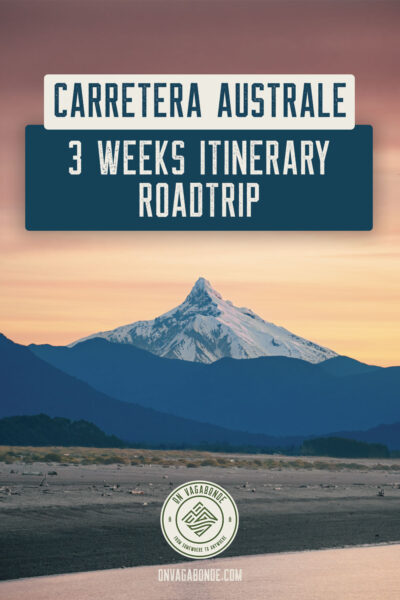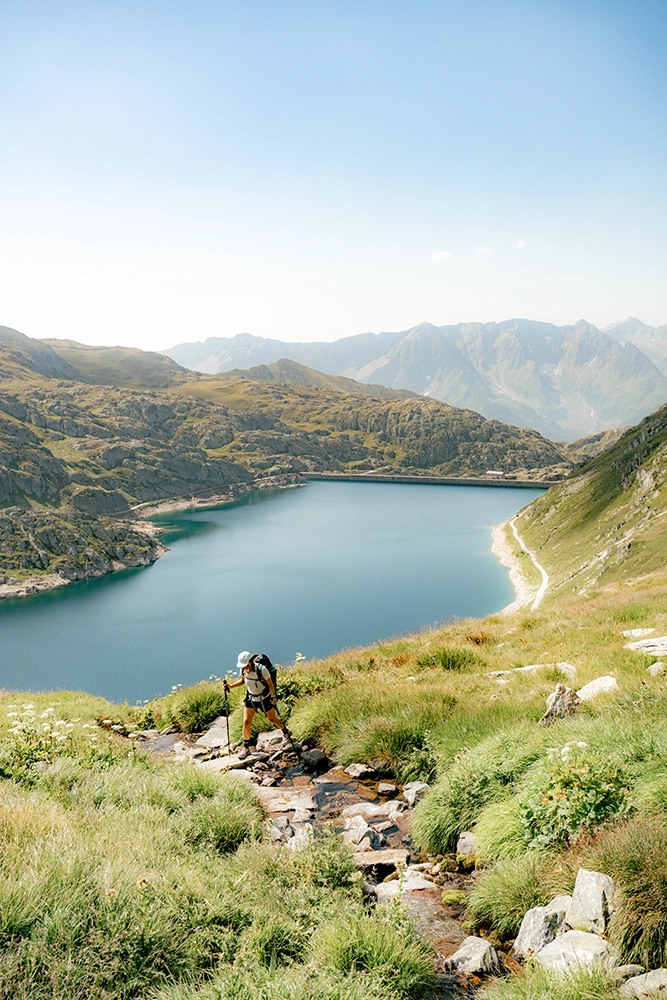A 3-week itinerary along the legendary Ruta 7, the Carretera Austral in Chile

Article updated on 08.03.25
The Carretera Austral, or Route 7, is an iconic route that winds its way through Chilean Patagonia, offering a unique adventure through wild and unspoilt landscapes. Stretching for around 1,240 km, this route is a real challenge for travellers in search of unspoilt nature, outdoor adventures and breathtaking scenery. If you’ve got three weeks to spare, here’s a detailed itinerary for discovering the Carretera Austral, with plenty to do along the way.

Our recommendations for travelling along the Carretera Austral
1. Choosing the right type of transport
Personal vehicle: Ideally, you should have your own vehicle, or even better, a converted vehicle that you can sleep in. All along the Carretera, there are plenty of free spots in the countryside where you can sleep in your own van. Respect the environment by following the ‘Leave No Trace’ principles!
Hitchhiking: Very popular on the Carretera Austral, but it can be slow and uncertain, especially in the less-frequented sections.
2. Getting your vehicle ready for ripio roads
For information, here are the different stretches of tarmac or ripio (gravel) road:
- Puerto Montt – Hornopirén : 106 km de route goudronnée.
- Caleta Gonzalo – Chaitén : 56 km de ripio (gravier).
- Chaitén – Villa Cerro Castillo : 515 km goudronnés.
- Villa Cerro Castillo – Villa O’Higgins : 463 km de ripio.
Tyres: Make sure you have good tyres and take something with you to change a tyre in case you get a flat.
Most important on ripio roads:
Deflate your tyres slightly at Copec stations to improve handling and reduce jolting on ripio sections.
3. Preparing fuel and provisions
Fuel: Take 1 or 2 jerry cans of gasoline with you. Fill up at every Copec station, even if your tank is almost full.
Food supplies: Do your main shopping in Puerto Montt, where you’ll find supermarkets. The next shops will mainly be local mini-markets with higher prices. In Coyhaique, you’ll again find real supermarkets to fill up on groceries, but prices will be a little more expensive than in Puerto Montt.

4. Have enough cash
ATMs can only be found in larger towns such as Puerto Montt and Coyhaique. Be sure to bring enough cash for small villages and certain services that do not accept cards.
5. Ferries
To cover the entire Carretera Austral, you’ll need to take at least two ferries:
- Hornopirén in Caleta Gonzalo : The route comprises two segments with two boats, one of which takes 4 hours. Book in advance, especially in high season, via the official website. Reservations are made automatically for both boats.
- Yungay in Río Bravo : Free and essential to reach Villa O’Higgins.
3-week itinerary on the Ruta 7
Days 1 to 3: Puerto Montt and Lago Llanquihue
The Carretera Austral begins in Puerto Montt, a bustling city in southern Chile, around 1,000 kilometres south of Santiago. Here are the region’s must-sees:
- Puerto Varas : Just 20 minutes from Puerto Montt, this charming little town is an excellent base for exploring the Lago Llanquihue. You can hike to the Reserva Nacional Llanquihue, heading for the Volcan Calbuco viewpoint and the Salto Rio Blanco (11 km round trip, +380m). The climb is moderate, and you’ll have a magnificent view of the surrounding volcanoes.
- Todos Los Santos : Don’t miss the blue river and lake of the same name. You can also hike up the Osorno volcano.








Days 4 to 5: Hornopirén and Termas del Sol
Around 4 hours’ drive from Puerto Montt, you arrive in Hornopirén, a picturesque little village on the shores of the lake. Before you get there, you can enjoy the Termas del Sol, natural hot springs with pools ranging from 36 to 45°C, a real comfort after a long day’s driving.
For hiking enthusiasts, the path leading to the Río Blanco waterfall(8 km round trip, +200m) is a great option.
You can then take the ferry between Hornopirén and Caleta Gonzalo. Don’t forget to book your tickets in advance, especially in high season, on their official website..




Days 6 to 9: Pumalín Park and Chaitén
Parc Pumalín is a true natural gem. Here you can discover ancient forests, rivers and spectacular waterfalls. It was the first National Park created by Douglas Tompkins (creator of The North Face brand) and his wife Kris Tompkins.
Cascadas Escondidas: an easy trail leading to two magnificent waterfalls (4.4 km round trip, +245m).
Volcan Chaitén: Hike up to the crater of this still active volcano. The climb is a little more difficult, but the views from the summit are incredible (5 km round trip, +620m).
Futalefú: If you’re looking for a thrill, opt for a rafting adventure down the Futalefú river, renowned for its rapids.






We strongly recommend watching the National Geographic documentary Wild Life, which explains the story of the creation of Chile’s national parks by Kris and Douglas Tompkins.
For more information:
Days 10 to 12: Villa Santa Lucia and Laguna Yelcho
Continuing on, you arrive at Villa Santa Lucia, a small town perfect for a break and a few hikes.
Ventisquero Yelcho Chico: Hike to a lookout point offering a breathtaking view of the glacier (6km round trip, +130m).
Laguna Pinilla: A hike to a magnificent blue lagoon (8km round trip, +890m). The start of the walk is on private property, Peuma Lodge. You’ll need to ask their permission, but it’s normally OK.
El Sauce Hot Springs: Relax in the natural thermal baths of El Sauce, with prior reservation via whatsapp.


Day 13: Queulat National Park
Queulat National Park is a must-see on the Carretera Austral, famous for its Ventisquero Colgante, a glacier suspended above a lagoon.
The hike to the mirador is accessible (7.6 km round trip, +370m), but remember to book your tickets in advance on the official website..

Day 14 to 15: Cerro Castillo
The next stop is Cerro Castillo, a magnificent mountain range whose iconic silhouette is one of the most famous in Chilean Patagonia..
Mirador Cuesta del Diablo : This viewpoint offers spectacular views of the S-shaped road.
Cerro Castillo : If you’re in good shape, a 12.6km return hike with a 1,120m vertical drop will take you to the Laguna Castillo. Experienced hikers can also continue to Laguna Duff (24 km round trip, +1,140 m).



Day 16 to 17: Puerto Río Tranquilo and Lago General Carrera
Arrival at Puerto Río Tranquilo, a picturesque village on the shores of the Lago General Carrera lake. Activities here are mainly lake-related.
Marble Caves: Hire a kayak to explore the famous marble caves, an unforgettable experience of kayaking in Patagonia.
Confluencia Río Baker: Hike to the viewpoint where the Baker and Nef rivers meet, an impressive sight (1.5 km round trip, +30m).







Days 18 to 20: Patagonia National Park
Patagonia National Park is an emblem of Patagonia. Here, the hikes are longer and offer views of the surrounding lagoons and mountains.
Lagunas Altas: This 20km hike, with a 930m ascent, will take you to the Lagunas Altas, with their breathtaking views of the wilderness. If you’re lucky, you might even come across some pumas.
Mirador Douglas Tompkins: Another excellent viewpoint from the Alto Valle campsite, with great panoramic views of Lake Cochrane (14km round trip, +380m).





Days 21 to 22: Villa O'Higgins
The last mythical stage of the Carretera Austral, Villa O’Higgins marks the end of this spectacular adventure.
To reach Villa O’Higgins, you’ll need to take a free ferry from Yungay to Río Bravo. This trip on the water adds a touch of adventure to your journey and offers unique views of the fjords.
Discover Caleta Tortel: Approximately 3 hours from Villa O’Higgins, this charming stilt town boasts wooden walkways linking the houses. It’s the perfect way to discover an authentic village and enjoy an enchanting setting.
Crossing to Puerto Natales : From Caleta Tortel, you can take a ferry to Puerto Natales, the starting point for exploring Torres del Paine National Park and beyond. This multi-day crossing offers a unique opportunity to see the secluded maritime landscapes of southern Patagonia. We strongly advise you to book your place a few days/weeks in advance.





The Carretera Austral is a journey that offers much more than just scenery. It’s an adventure in a natural environment of breathtaking beauty, with endless opportunities for hiking, outdoor activities and total immersion in wild Patagonia. Get ready for an unforgettable road trip through one of the most remote and unspoilt corners of the world.
Did you like the article?
Pin it !





Leave a Reply